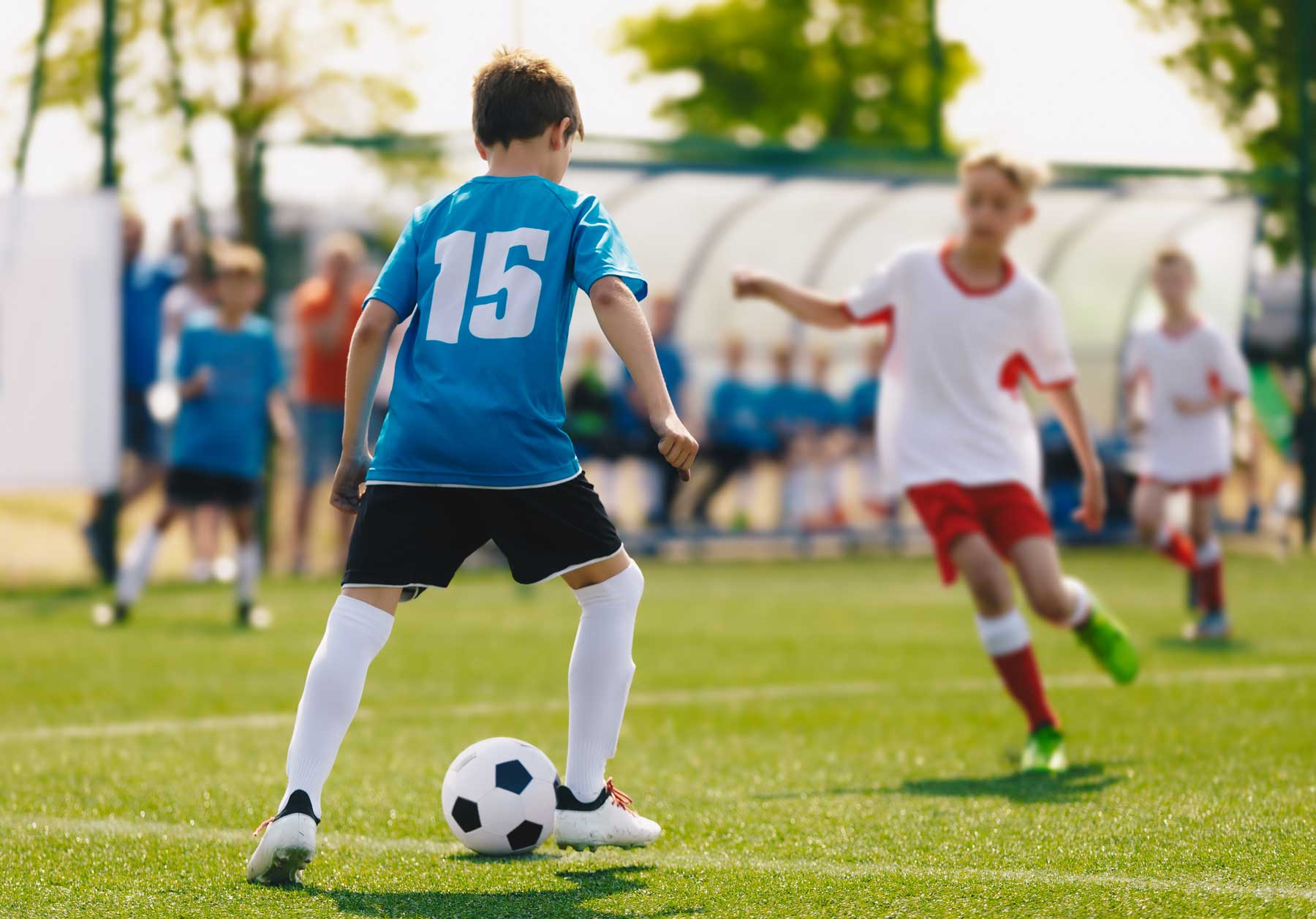Youth Soccer Series: A Parent’s Guide to Core Positions and Rules – Part 2
Basic Rules of Soccer
Part 2
Coaches are soccer players’ main source of knowledge when it comes to playing the game, especially when it comes to following age-appropriate youth soccer rules. Because many coaches may have their children on their teams, players’ families should understand the basic rules of soccer and the positions.
Families cheer for their players, but it’s important that they understand what’s going on. Shouting the wrong instructions or being upset at a legitimate call can be distracting and disruptive for all players.
Discovering the ‘Laws’ of Soccer
According to U.S. Youth Soccer, U6-U12 players use smaller fields and age-appropriate equipment that is designed especially for them. These modified rules make it safer and more fun for them to learn while playing soccer.
Each level offers a solid foundation as players grow and advance in their game. FIFA rules are increasingly followed for advancing age groups. Unless noted, U14-U19 players follow the standard FIFA Laws of the Game, and families are encouraged to become familiar with those rules.
Law 1: Field of Play
All soccer fields/pitches must be rectangular. Smaller fields for U6-U12 are designed to accommodate the players’ skill levels and size.
- U6-U8: Fields measure 25 to 35 yards long and 15 to 25 yards wide. A halfway line divides the field of play into two halves with a center mark at its midpoint.
- Corner flags are optional, and there are no corner arcs, goal areas, or penalty areas. Goals are placed on the center of each goal line, with upright posts (6 feet apart) joined at the top by a horizontal crossbar that is 4 feet above the ground. These age groups may use smaller goals
- U10: Fields are 55 5o 65 yards long and 35 to 45 yards wide. The goal area is 4 yards from the goal line and 8 yards wide. The penalty area is 24 yards wide and 12 yards from the goal line and has a penalty arc. The goal is 12 feet across and 6 feet high.
- U12: Fields are 70 to 80 yards long and 45 to 55 yards wide. The goal area is 5 yards from the goal line and 16 yards wide. The penalty area is 36 yards wide and 14 yards from the goal line. The goal is 18 feet across and 6 feet high.
- U14-U19: These age groups play on regulation-size fields (100 to 130 yards long and 50 to 100 yards wide).
Law 2: The Ball
All youth soccer balls must be FIFA quality. Each ball size encourages proper kicking and ball handling skills, accommodating each player’s size, bone and muscle development, and kicking strength.
- U6-U8: Size 3 soccer balls are 23 to 24 inches in diameter and weigh 320 grams.
- U10-U12: Size 4 soccer balls are 25 to 26 inches in diameter and weigh 350 to 390 grams.
- U14-U19: Size 5,regulation soccer balls are 27 to 28 inches in diameter and weigh 410 to 450 grams.
Law 3: Number of Players
All players from U6 to U19 are given the opportunity to play 50% of the game.
- U6: Maximum of four players. There are no goalkeepers, and coaches can make unlimited substitutions during a stoppage in play.
- U8: Maximum of six players, including a goalkeeper. Coaches can make unlimited substitutions during a stoppage in play.
- U10: Maximum of seven players, including a goalkeeper. Coaches can make unlimited substitutions during a stoppage in play with referee permission.
- U12: Maximum of eight players, including a goalkeeper. Coaches can make unlimited substitutions during a stoppage in play with referee permission.
- U14-U19: Maximum of 11 players, including a goalkeeper. Coaches may make unlimited substitutions only on kick-offs, goal kicks, to start of a half, or on their own throw-in.
Law 4: Player Equipment
- U6-U8: During practices and games, players must wear shin guards under their socks. Although cleats are recommended, they are not required. Players may not wear baseball cleats with a toe cleat or metal spikes. No player may wear jewelry or anything that could be dangerous or potentially harmful to themselves or other players. Medical alert bracelets may be allowed.
- U10-19: Follow FIFA Laws of the Game.
Law 5 and Law 6: The Referee and Assistant Referee
FIFA’s Law 5 states, “Each match is controlled by a referee who has full authority to enforce the Laws of the Game in connection with the match.” Coaches and parents should remember that many youth referees are teenagers. Arguing with the referee may result in a yellow or red card. Spectators are never allowed to address the referee or enter the field or team seating area.
- U6: Coaches and parents may officiate these games. They should apply rules with flexibility to allow fun and safe play. Officials should explain infringements to the players.
- U8: Officiated by a qualified referee who calls basic fouls and boundaries. Officials should explain infringements to the players.
- U10-U12: Officiated by a U.S. Soccer certified referee (grade 9, parent, or coach/assistant coach). Assistant referees or club linesmen/women are allowed.
- U14-U19: These games are officiated by a center referee and two assistant referees or club linesmen.
Law 8: Start and Restart of Play
U6-U8: The team winning the coin toss chooses the goal they will defend to start the game. The other team kicks from the center mark to begin play. Teams alternate kicks from the center mark to begin each quarter. Players cannot touch the ball twice at the start of play.
- U10-U12: Follow FIFA Laws of the Game. The defending team should be 8 yards away from the ball until it is in play.
- U14-U19: Follow FIFA Laws of the Game.
Law 9: Ball In and Out of Play
- U6-U8: The ball is in play until it completely crosses the goal line or touchline/sideline.
- U10-U19: Follow FIFA Laws of the Game.
Law 10: Method of Scoring
- U6-U8: A goal is considered scored when the ball completely crosses the goal line, below the crossbar and between the goal posts.
- U10-U19: Follow FIFA Laws of the Game.
Law 11: Offside
- U6-U10: Offside is not called.
- U12-U19: Follow FIFA Laws of the Game. A player is offside when they are in the opponent’s half of the field, closer to the goal than the second-to-last defender and/or the ball and are involved in the play.
Fouls and Free Kicks
Law 12: Fouls and Misconduct
Yellow or red cards are never shown for U6 to U10 players, and heading the ball isn’t allowed for U6 to U12 players.
- U6: Any infractions should be explained to the player. Following inappropriate behavior, coaches should bring the player off the field for a cool-down period.
- U8: All fouls, including if a player intentionally handles or heads the ball, result in an indirect free kick.
- U10: Follow the FIFA Laws of the Game, except an indirect free kick is awarded to the opposing team after a player deliberately heads the ball. Contact (pushing, tripping) and noncontact fouls (dangerous play, obstruction) can be called.
- U12-U19: Follow the FIFA Laws of the Game. Yellow or red cards are given for careless or reckless fouls.
Law 13: Free Kicks
- U6: Free kicks are always indirect, and opponents should be 4+ yards from the ball until it’s kicked.
- U8: The same as U6, except opponents should be 5+ yards from the ball until it’s kicked.
- U10: In indirect free kicks, opponents should be 8+ yards from the ball until it’s kicked.
- U12: Follow FIFA Laws of the game. Opponents should be 8+ yards from the ball until it’s kicked.
- U14-U19: Follow FIFA Laws of the game. A player can score a goal from a direct kick. Another player must touch the ball on an indirect kick before the goal can be scored.
Throw Ins, Corner Kicks, and Goal Kicks
Law 15: Throw-In
- U6: Players take a throw-in or pass-in when the ball completely crosses the touchline.
- U8: Players can make a second attempt after an illegal throw-in, such as when the back foot is raised. After the second attempt, the opposing team is awarded a throw-in. Players may also take a pass-in.
- U10-U19: Follow the FIFA Laws of the Game.
Law 16: Goal Kick
- U6: The defense takes a goal kick when the ball crosses the goal line after last touching an offensive player. The ball is placed on the goal line one yard to the outside of either goal post. This age group uses kick-ins or dribble-ins.
- U8: The ball is placed within 5 yards of the goal, and opposing players must be 5+ yards away until the ball is kicked. The ball must leave the goal area to be in play or the kick is retaken.
- U10: Follow the FIFA Laws of the Game, except opposing players must be behind the build-out line until the ball is kicked.
- U12-U19: Follow the FIFA Laws of the Game.
Law 17: Corner Kick
- U6: The offense takes a corner kick when the ball crosses the opponent’s goal line after touching a defensive player. U6 uses kick-ins or dribble-ins.
- U8: Opponents must be 5+ yards away from the ball until it’s kicked.
- U10-U12: Follow the FIFA Laws of the Game. Opponents must be 8+ yards away from the ball until it’s kicked.
Penalty Kicks
Law 14: Penalty Kick
- U6-U8: No penalty kicks are awarded.
- U10-U12: Follow the FIFA Laws of the Game, except the penalty mark is 10 yards from the goal line.
- U14-U19: Follow the FIFA Laws of the Game. A penalty kick is given when the defense commits a direct free kick foul in the penalty area. A goal may be scored from a penalty kick.
Game Duration
Law 7: Duration of the Match
- U6: Four 8-minute quarters, with 2 to 5-minute breaks between quarters and a 5-minute halftime break.
- U8: Four 10-minute quarters with 5-minute breaks between quarters.
- U10: Four 12-minute quarters with 2-minute breaks between quarters and a 5-minute halftime break.
- U12: Two 30-minute halves with a 10-minute halftime break.
- U14: Two 35-minute halves with a 10-minute halftime break.
- U16: Two 40-minute halves with a 10-minute halftime break.
- U19: Two 45-minute halves with a 10-minute halftime break.
Reference
Each of our league of platforms will have it’s on rules on when substitutes can happen and if there can be re-entry into the game. Please check with our relevant regional soccer management teams.
Would you like to know more about the rules of soccer?
We’d like to hear from you and answer any questions you may have.
Share This Post

